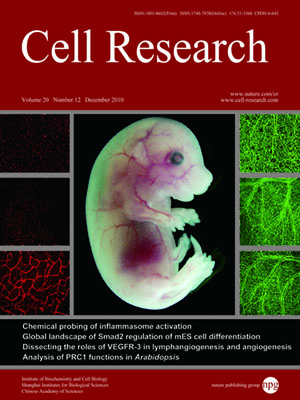
Volume 20, No 12, Dec 2010
ISSN: 1001-0602
EISSN: 1748-7838 2018
impact factor 17.848*
(Clarivate Analytics, 2019)
Volume 20 Issue 12, December 2010: 1372-1385
ORIGINAL ARTICLES
Physiological levels of ATP negatively regulate proteasome function
Hongbiao Huang1,*, Xiaoyan Zhang1,*, Shujue Li1,*, Ningning Liu1,*, Wen Lian1,*, Emily McDowell2, Ping Zhou1, Canguo Zhao1, Haiping Guo1, Change Zhang1, Changshan Yang1, Guangmei Wen1, Xiaoxian Dong1, Li Lu1, Ningfang Ma1, Weihua Dong1, Q. Ping Dou1,3,4, Xuejun Wang1,2 and Jinbao Liu1
1Protein Modification and Degradation Lab, Department of Pathophysiology, Guangzhou Medical College, Guangzhou, Guangdong 510182, China
2Division of Basic Biomedical Sciences, Sanford School of Medicine of the University of South Dakota, Vermillion, SD 57069, USA
3The Prevention Program, Barbara Ann Karmanos Cancer Institute, Wayne State University, Detroit, MI 48201, USA
4Department of Pathology, School of Medicine, Wayne State University, Detroit, MI 48201, USA
Correspondence: Jinbao Liu, Xuejun Wang,(liujinbao1@yahoo.com.cn; xuejun.wang@usd.edu)
Intracellular protein degradation by the ubiquitin-proteasome system is ATP dependent, and the optimal ATP concentration to activate proteasome function
in vitro is ~100 μM. Intracellular ATP levels are generally in the low millimolar range, but ATP at a level within this range was shown to inhibit proteasome peptidase activities
in vitro. Here, we report new evidence that supports a hypothesis that intracellular ATP at the physiological levels bidirectionally regulates 26S proteasome proteolytic function in the cell. First, we confirmed that ATP exerted bidirectional regulation on the 26S proteasome
in vitro, with the optimal ATP concentration (between 50 and 100 μM) stimulating proteasome chymotrypsin-like activities. Second, we found that manipulating intracellular ATP levels also led to bidirectional changes in the levels of proteasome-specific protein substrates in cultured cells. Finally, measures to increase intracellular ATP enhanced, while decreasing intracellular ATP attenuated the ability of proteasome inhibition to induce cell death. These data strongly suggest that endogenous ATP within the physiological concentration range can exert a negative impact on proteasome activities, allowing the cell to rapidly upregulate proteasome activity on ATP reduction under stress conditions.
Cell Research (2010) 20:1372-1385. doi:10.1038/cr.2010.123; published online 31 August 2010
FULL TEXT | PDF
Browse 2503


